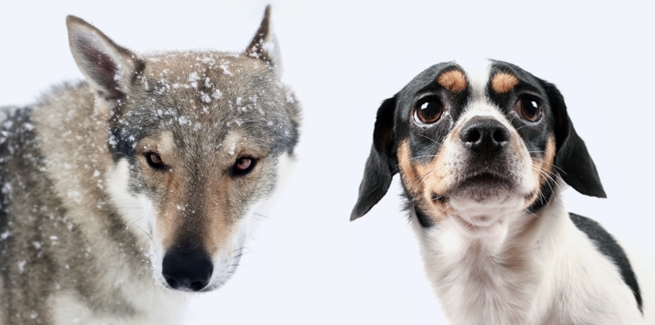Study: Dogs evolved to make us go all mushy inside

Which one do you want to cuddle?
If you picked the one on the right, there’s a reason.
In the first detailed study comparing the anatomy and behavior of dogs and wolves, researchers at the University of Portsmouth’s Dog Cognition Center in the UK examined the heads of six dogs and two wolves. They found the facial structure of both animals was mostly very similar, except above the eyes. Dogs have a small muscle around each eye that wolves do not.
And that muscle may be the reason you want to cuddle them so much.
The muscle allows dogs to raise their inner eyebrows. A lot. That’s something wolves just can’t do—without those extra muscles, wolves don’t have the ability to be that expressive.
The researchers suggest that when dogs raise their inner eyebrows, it triggers a nurturing response in humans because it makes the dogs’ eyes appear larger and more baby like. It also resembles a movement that humans of all ages produce when they’re sad.
Juliane Kaminski, PhD, lead researcher and a lecturer in Comparative Psychology at the University of Portsmouth, said there’s compelling evidence that dogs developed that muscle after humans domesticated them: “The findings suggest that expressive eyebrows in dogs may be a result of humans’ unconscious preferences that influenced selection during domestication.”
That domestication took place about 33,000 years ago and, during that process, dogs changed physically and behaviorally as they adapted to life with humans. And developing that small, extra muscle was a game changer.
When dogs make that eye movement, Kaminski said, it seems to make humans want to look after them. This would give dogs who move their eyebrows more an evolutionary advantage over dogs who don’t, and reinforce the puppy-dog eyes trait for future generations.
In a separate part of the study, Kaminski’s team observed how 27 dogs and 9 wolves interacted with a human. “When exposed to a human for two minutes, dogs raised their inner eyebrows more and at higher intensities than wolves,” Kaminski said.
The researchers also suggested that dogs developed the eye movements over time as a way to get humans to do things for them, such as giving them food, care, and attention.
These findings support previous research by Kaminski, which showed that dogs move their eyebrows a lot more when people are looking at them.
The only dog species in the study that did not have the muscles was the Siberian husky, an ancient breed, which could mean the husky is best living example of the missing link between dogs and wolves.
So the next time a dog gives you those big, puppy-dog eyes and you go all mushy inside, remember:
You’re being played. (But come on—you probably don’t mind.)
Photo Credit: © iStock/andreafidone/Lyly



